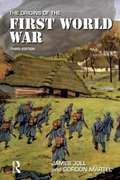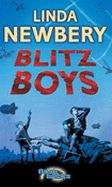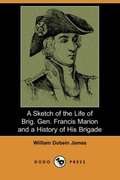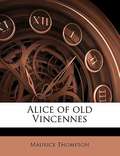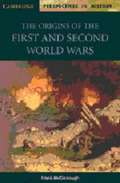- Table View
- List View
The Origins Of The First World War (PDF)
by James Joll Gordon MartelJames Joll's study is not simply another narrative, retracing the powder trail that was finally ignited at Sarajevo. It is an ambitious and wide-ranging analysis of the historical forces at work in the Europe of 1914, and the very different ways in which historians have subsequently attempted to understand them. The importance of the theme, the breadth and sympathy of James Joll's scholarship, and the clarity of his exposition, have all contributed to the spectacular success of the book since its first appearance in 1984. Revised by Gordon Martel, this new 3rd edition accommodates recent research and an expanded further reading section.
Recollections and Letters of General Robert E. Lee
by Robert E. LeeGeneral Robert E. Lee was the most heroic figure of the Civil War, but to many, he is a solitary figure. This book fleshes out the man and reveals the workings of a great military mind and a warm, understanding, and generous human being. It shows all the facets of the general during the war; at the conclusion, when he was an outspoken proponent of a reasonable peace which would allow the South to rejoin the Union; and after the war, when he served as president of Washington College, and became a driving force for the creation of a viable educational system. This anthology shows all these facets of the general, through his correspondence and through the revealing insight supplied by his son. No other collection of source materials gives such a whole and rewarding picture of one of the South's greatest sons and heroes.
Blitz Boys (PDF)
by Linda NewberyExploring a bombed house one day, a boy makes a friend whose father is a pilot. His mind is filled with awe, but he comes to realise the difference between the heroism of fantasy and what people do when their courage is really needed.
A Sketch of the Life of Brig. Gen. Francis Marion and a History of His Brigade
by William Dobein James1821 biography of Francis Marion, the lieutenant colonel in the Continental Army and later Brigadier General in the South Carolina Militia during the American Revolutionary War. <P> <P> He became known as the "Swamp Fox" for his ability to use decoy and ambush tactics to disrupt enemy communications, capture supplies, and free prisoners. His incorporation of guerilla tactics helped set the motions for later combat events in which fighting in open battlefields would decline in use. His occupation before the Revolutionary War was as a sailor. Marion is considered one of the fathers of modern guerilla warfare, and is credited in the lineage of the United States Army Rangers.
Alice of Old Vincennes
by Maurice ThompsonSet against the backdrop of the American Revolution Alice of Old Vincennes is the story of the orphan girl Alice Roussillon. In 1778 the French outpost of Vincennes, Indiana revolts against the British and swears allegiance to the American cause. <P> <P> Hoisting her hand-made American flag over the fort Alice provides the rallying symbol of the cause of liberty. The handsome Virginian Lt. Fitzhugh Beverly proves to be both a noble companion in arms as well as of the heart. When the British retake Vincennes the rallying cry Viva la banniere d'Alice Roussillon is heard throughout the land. The true battle for liberty and love has begun.
The Origins Of The First And Second World Wars (PDF)
by Frank Mcdonough Richard Brown David SmithAn engaging range of period texts and theme books for AS and A Level history. This text analyses the origins of the First and Second World Wars in one single volume, drawing on a wide range of material, including original sources. In concise chapters, Frank McDonough surveys the key issues surrounding the causes of the First and Second World Wars, offers a critical survey of the conflict between historians and provides a lively selection of primary documents on major issues. The result is a unique perspective on the origins of the two most devastating military conflicts in world history.
Aeroplane (UEB Contracted)
by RnibThis is an image of an aeroplane viewed from above. There is a locator dot shown, which will be at the top left of the page when the image is the right way up. The front (nose) of the aeroplane is at the left of the page, and the back (tail) on the right. The cockpit, where the pilot sits, is near the nose of the aeroplane. To the right of this is the long main cabin for the passengers. On each side of the passenger cabin there is a long wing. Each wing has an engine on the front, and flaps to control the aeroplane at the rear. The smaller wings making up the tail also have flaps at the rear.
Aeroplane (UEB Uncontracted)
by RnibThis is an image of an aeroplane viewed from above. There is a locator dot shown, which will be at the top left of the page when the image is the right way up. The front (nose) of the aeroplane is at the left of the page, and the back (tail) on the right. The cockpit, where the pilot sits, is near the nose of the aeroplane. To the right of this is the long main cabin for the passengers. On each side of the passenger cabin there is a long wing. Each wing has an engine on the front, and flaps to control the aeroplane at the rear. The smaller wings making up the tail also have flaps at the rear.
Air-sea rescue helicopter (Large Print)
by RnibThe helicopter is viewed from the side with only one of its main wheels showing at the lower centre of the page, and with a tail wheel to its right. There is a locator dot shown, which will be at the top left of the page when the image is the right way up. The cockpit at the front is on the left of the page and the tail on the right. The long rotor blades stretch from the left of the page to the right, above the helicopter body. On the left of the body there are three cockpit windows, up from these is the engine grill. Up from the main wheel one of the helicopter's floats is shown and two more windows. To the right of these is the open hatch through which people are winched during rescue missions. Right from the hatch is another window. Above the hatch and single window is the radar dome on the top edge of the helicopter. At the far right of the page is the six bladed tail rotor.
Air-sea rescue helicopter (UEB Contracted)
by RnibThe helicopter is viewed from the side with only one of its main wheels showing at the lower centre of the page, and with a tail wheel to its right. There is a locator dot shown, which will be at the top left of the page when the image is the right way up. The cockpit at the front is on the left of the page and the tail on the right. The long rotor blades stretch from the left of the page to the right, above the helicopter body. On the left of the body there are three cockpit windows, up from these is the engine grill. Up from the main wheel one of the helicopter's floats is shown and two more windows. To the right of these is the open hatch through which people are winched during rescue missions. Right from the hatch is another window. Above the hatch and single window is the radar dome on the top edge of the helicopter. At the far right of the page is the six bladed tail rotor.
Air-sea rescue helicopter (UEB Uncontracted)
by RnibThe helicopter is viewed from the side with only one of its main wheels showing at the lower centre of the page, and with a tail wheel to its right. There is a locator dot shown, which will be at the top left of the page when the image is the right way up. The cockpit at the front is on the left of the page and the tail on the right. The long rotor blades stretch from the left of the page to the right, above the helicopter body. On the left of the body there are three cockpit windows, up from these is the engine grill. Up from the main wheel one of the helicopter's floats is shown and two more windows. To the right of these is the open hatch through which people are winched during rescue missions. Right from the hatch is another window. Above the hatch and single window is the radar dome on the top edge of the helicopter. At the far right of the page is the six bladed tail rotor.
Electric Motor (Large Print)
In these diagrams of an electric motor, there is an end view on the left of the page and a top view on the right of the page, separated by a vertical dashed line. There is a locator dot shown, which will be at the top left of the page when the image is the right way up. On the end view there is a permanent magnet of south polarity on the left of the page. To the right of this is a large circle which has four electro-magnets around its outer edge. Inside the circle are some thick lines which represent electrical wires that connect the magnets in pairs. Only the wiring connecting one pair of electro-magnets is shown. In the centre is the commutator with the axle in its centre. To the bottom left and upper right of the commutator are the electrical brushes with wires going to the battery (which is not shown). On the far right of the page is a permanent magnet of north polarity. The top view on the right of the page shows the commutator in the bottom right of the page with a single brush. Up from this the electro-magnets are shown. In the end view the permanent magnets to the left and right of the page remain static. The brushes and the wires to the battery also remain static. The electro-magnets, their wiring and the commutator rotate on the axle. The image shows the moment when the positive brush, seen to the upper right of the commutator, supplies electricity to a quadrant of the commutator. This quadrant can then supply electricity via the upper vertical wire to the electro-magnet at the top of the page. The current makes it magnetic with south polarity. This results in the electro-magnet being attracted to and rotating towards the permanent north magnet on the right of the page. The electricity from the charged south electro-magnet flows onwards to the electro-magnet on the opposite side of the diagram, at the bottom of the page, via the longer curved wire. The lower electro-magnet becomes magnetic with north polarity because of the direction of the wiring. This results in the electro-magnet rotating towards the permanent south magnet on the left of the page. The north polarity electro-magnet is currently connected via a vertical wire to a different quadrant of the commutator. As the negative brush contacts this the current can flow back to the battery thus completing the circuit. When this electro-magnet reaches the upper position it will be supplied with electricity again but flowing in the opposite direction so it will become an electro-magnet with south polarity. When the motor is running the pairs of electro-magnets are constantly being turned on and off by the commutator.
Electric Motor (UEB Contracted)
In these diagrams of an electric motor, there is an end view on the left of the page and a top view on the right of the page, separated by a vertical dashed line. There is a locator dot shown, which will be at the top left of the page when the image is the right way up. On the end view there is a permanent magnet of south polarity on the left of the page. To the right of this is a large circle which has four electro-magnets around its outer edge. Inside the circle are some thick lines which represent electrical wires that connect the magnets in pairs. Only the wiring connecting one pair of electro-magnets is shown. In the centre is the commutator with the axle in its centre. To the bottom left and upper right of the commutator are the electrical brushes with wires going to the battery (which is not shown). On the far right of the page is a permanent magnet of north polarity. The top view on the right of the page shows the commutator in the bottom right of the page with a single brush. Up from this the electro-magnets are shown. In the end view the permanent magnets to the left and right of the page remain static. The brushes and the wires to the battery also remain static. The electro-magnets, their wiring and the commutator rotate on the axle. The image shows the moment when the positive brush, seen to the upper right of the commutator, supplies electricity to a quadrant of the commutator. This quadrant can then supply electricity via the upper vertical wire to the electro-magnet at the top of the page. The current makes it magnetic with south polarity. This results in the electro-magnet being attracted to and rotating towards the permanent north magnet on the right of the page. The electricity from the charged south electro-magnet flows onwards to the electro-magnet on the opposite side of the diagram, at the bottom of the page, via the longer curved wire. The lower electro-magnet becomes magnetic with north polarity because of the direction of the wiring. This results in the electro-magnet rotating towards the permanent south magnet on the left of the page. The north polarity electro-magnet is currently connected via a vertical wire to a different quadrant of the commutator. As the negative brush contacts this the current can flow back to the battery thus completing the circuit. When this electro-magnet reaches the upper position it will be supplied with electricity again but flowing in the opposite direction so it will become an electro-magnet with south polarity. When the motor is running the pairs of electro-magnets are constantly being turned on and off by the commutator.
Electric Motor (UEB Uncontracted)
In these diagrams of an electric motor, there is an end view on the left of the page and a top view on the right of the page, separated by a vertical dashed line. There is a locator dot shown, which will be at the top left of the page when the image is the right way up. On the end view there is a permanent magnet of south polarity on the left of the page. To the right of this is a large circle which has four electro-magnets around its outer edge. Inside the circle are some thick lines which represent electrical wires that connect the magnets in pairs. Only the wiring connecting one pair of electro-magnets is shown. In the centre is the commutator with the axle in its centre. To the bottom left and upper right of the commutator are the electrical brushes with wires going to the battery (which is not shown). On the far right of the page is a permanent magnet of north polarity. The top view on the right of the page shows the commutator in the bottom right of the page with a single brush. Up from this the electro-magnets are shown. In the end view the permanent magnets to the left and right of the page remain static. The brushes and the wires to the battery also remain static. The electro-magnets, their wiring and the commutator rotate on the axle. The image shows the moment when the positive brush, seen to the upper right of the commutator, supplies electricity to a quadrant of the commutator. This quadrant can then supply electricity via the upper vertical wire to the electro-magnet at the top of the page. The current makes it magnetic with south polarity. This results in the electro-magnet being attracted to and rotating towards the permanent north magnet on the right of the page. The electricity from the charged south electro-magnet flows onwards to the electro-magnet on the opposite side of the diagram, at the bottom of the page, via the longer curved wire. The lower electro-magnet becomes magnetic with north polarity because of the direction of the wiring. This results in the electro-magnet rotating towards the permanent south magnet on the left of the page. The north polarity electro-magnet is currently connected via a vertical wire to a different quadrant of the commutator. As the negative brush contacts this the current can flow back to the battery thus completing the circuit. When this electro-magnet reaches the upper position it will be supplied with electricity again but flowing in the opposite direction so it will become an electro-magnet with south polarity. When the motor is running the pairs of electro-magnets are constantly being turned on and off by the commutator.
Internal combustion engine - Multipage image (Large Print)
These diagrams of an internal combustion engine are on two pages with two diagrams per page, separated by a vertical dotted line. There is a locator dot shown, which will be at the top left of the page when the image is the right way up. Each diagram is titled in the top left and shows a phase of the combustion engine cycle. In the top of each diagram from left to right there is an intake valve, a spark plug and an exhaust valve. In the centre of the image is the cylinder with the piston in its middle. This has a water cooling jacket to the left and right. The piston is connected by a connecting rod to the crankshaft and axle at the bottom of the image. Not all elements are labelled on every diagram. The valves and crankshaft are also in different positions. The crankshaft is continuously turning clockwise (with the top moving to the right) throughout all stages. In the first diagram fuel is being drawn into the cylinder through the open intake valve as the piston moves down. In the second diagram the intake valve has closed, the piston moves up and the air and fuel mixture is squashed. In the third diagram the air and fuel mixture has been ignited by a spark from the spark plug. The mixture burns and expands rapidly driving the piston down. In the last diagram the exhaust valve is open and the piston moves up driving the exhaust out of the cylinder. There are usually at least two cylinders which comprise the whole engine. They all drive the same crankshaft but are phased so that, for example, while one cylinder will be sucking air and fuel in, another will be burning the compressed mixture and generating the power.
Internal combustion engine - Multipage image (UEB Contracted)
These diagrams of an internal combustion engine are on two pages with two diagrams per page, separated by a vertical dotted line. There is a locator dot shown, which will be at the top left of the page when the image is the right way up. Each diagram is titled in the top left and shows a phase of the combustion engine cycle. In the top of each diagram from left to right there is an intake valve, a spark plug and an exhaust valve. In the centre of the image is the cylinder with the piston in its middle. This has a water cooling jacket to the left and right. The piston is connected by a connecting rod to the crankshaft and axle at the bottom of the image. Not all elements are labelled on every diagram. The valves and crankshaft are also in different positions. The crankshaft is continuously turning clockwise (with the top moving to the right) throughout all stages. In the first diagram fuel is being drawn into the cylinder through the open intake valve as the piston moves down. In the second diagram the intake valve has closed, the piston moves up and the air and fuel mixture is squashed. In the third diagram the air and fuel mixture has been ignited by a spark from the spark plug. The mixture burns and expands rapidly driving the piston down. In the last diagram the exhaust valve is open and the piston moves up driving the exhaust out of the cylinder. There are usually at least two cylinders which comprise the whole engine. They all drive the same crankshaft but are phased so that, for example, while one cylinder will be sucking air and fuel in, another will be burning the compressed mixture and generating the power.
Internal combustion engine - Multipage image (UEB Uncontracted)
These diagrams of an internal combustion engine are on two pages with two diagrams per page, separated by a vertical dotted line. There is a locator dot shown, which will be at the top left of the page when the image is the right way up. Each diagram is titled in the top left and shows a phase of the combustion engine cycle. In the top of each diagram from left to right there is an intake valve, a spark plug and an exhaust valve. In the centre of the image is the cylinder with the piston in its middle. This has a water cooling jacket to the left and right. The piston is connected by a connecting rod to the crankshaft and axle at the bottom of the image. Not all elements are labelled on every diagram. The valves and crankshaft are also in different positions. The crankshaft is continuously turning clockwise (with the top moving to the right) throughout all stages. In the first diagram fuel is being drawn into the cylinder through the open intake valve as the piston moves down. In the second diagram the intake valve has closed, the piston moves up and the air and fuel mixture is squashed. In the third diagram the air and fuel mixture has been ignited by a spark from the spark plug. The mixture burns and expands rapidly driving the piston down. In the last diagram the exhaust valve is open and the piston moves up driving the exhaust out of the cylinder. There are usually at least two cylinders which comprise the whole engine. They all drive the same crankshaft but are phased so that, for example, while one cylinder will be sucking air and fuel in, another will be burning the compressed mixture and generating the power.
Jet Turbine engine cross section (UEB Contracted)
In these diagrams of a jet engine, there is a cross section view through the length of the engine at the top of the page and in the bottom right of the page, a front view of the engine intake. There is a locator dot shown, which will be at the top left of the page when the image is the right way up. On the left of the page air is forced into the engine by the compressor which has many fan blades. The compressed air is fed into the combustion chamber in the middle of the page. Fuel is injected into the engine through a port in the lower centre part of the combustion chamber. This is where combustion and gas expansion takes place. On the right of the page the exhaust exits past the turbine producing the thrust of the engine. The front view shows the circular opening of the engine with lots of fan blades arranged around the central hub like a huge fan.
Jet Turbine engine cross section (UEB Uncontracted)
In these diagrams of a jet engine, there is a cross section view through the length of the engine at the top of the page and in the bottom right of the page, a front view of the engine intake. There is a locator dot shown, which will be at the top left of the page when the image is the right way up. On the left of the page air is forced into the engine by the compressor which has many fan blades. The compressed air is fed into the combustion chamber in the middle of the page. Fuel is injected into the engine through a port in the lower centre part of the combustion chamber. This is where combustion and gas expansion takes place. On the right of the page the exhaust exits past the turbine producing the thrust of the engine. The front view shows the circular opening of the engine with lots of fan blades arranged around the central hub like a huge fan.
Steam Engine - Multipage image (Large Print)
These diagrams of a steam engine are on two pages with two diagrams on the first page separated by a horizontal dashed line and one diagram on the second page. There is a locator dot shown, which will be at the top left of the page when the image is the right way up. Each diagram is titled in the top left and shows a phase of the steam engine cycle. In each diagram there is a crankshaft and axle on the left of the image. This is linked by the crosshead guide to the piston inside the cylinder on the right of the image. Sitting on the crosshead guide is the crosshead. This is linked by the control rod obliquely right up to the valve rod. The valve rod goes horizontally right through the top of the cylinder. Immediately down from the centre of the valve rod is the valve itself and down from this is steam exhaust vent (steam out). Steam is forced under pressure continuously into the steam inlet at the top right of the diagram. The crankshaft rotates anti-clockwise (with the top moving to the left) throughout all stages. In the first diagram steam flows around the valve rod and into the left side of the cylinder. This pushes the piston to the right starting the forward stroke. In the second diagram, as the stroke approaches completion, the crosshead catches the end of the control rod. In the third diagram the control rod pivots, pulling the valve rod sharply to the left. This moves the valve to the left as well. The steam now flows around the valve rod and into the right side of the cylinder. This starts the reverse stroke with the piston moving left. As it moves left it forces the low pressure exhaust steam out.
Steam Engine - Multipage image (UEB Contracted)
These diagrams of a steam engine are on two pages with two diagrams on the first page separated by a horizontal dashed line and one diagram on the second page. There is a locator dot shown, which will be at the top left of the page when the image is the right way up. Each diagram is titled in the top left and shows a phase of the steam engine cycle. In each diagram there is a crankshaft and axle on the left of the image. This is linked by the crosshead guide to the piston inside the cylinder on the right of the image. Sitting on the crosshead guide is the crosshead. This is linked by the control rod obliquely right up to the valve rod. The valve rod goes horizontally right through the top of the cylinder. Immediately down from the centre of the valve rod is the valve itself and down from this is steam exhaust vent (steam out). Steam is forced under pressure continuously into the steam inlet at the top right of the diagram. The crankshaft rotates anti-clockwise (with the top moving to the left) throughout all stages. In the first diagram steam flows around the valve rod and into the left side of the cylinder. This pushes the piston to the right starting the forward stroke. In the second diagram, as the stroke approaches completion, the crosshead catches the end of the control rod. In the third diagram the control rod pivots, pulling the valve rod sharply to the left. This moves the valve to the left as well. The steam now flows around the valve rod and into the right side of the cylinder. This starts the reverse stroke with the piston moving left. As it moves left it forces the low pressure exhaust steam out.
Steam Engine - Multipage image (UEB Uncontracted)
These diagrams of a steam engine are on two pages with two diagrams on the first page separated by a horizontal dashed line and one diagram on the second page. There is a locator dot shown, which will be at the top left of the page when the image is the right way up. Each diagram is titled in the top left and shows a phase of the steam engine cycle. In each diagram there is a crankshaft and axle on the left of the image. This is linked by the crosshead guide to the piston inside the cylinder on the right of the image. Sitting on the crosshead guide is the crosshead. This is linked by the control rod obliquely right up to the valve rod. The valve rod goes horizontally right through the top of the cylinder. Immediately down from the centre of the valve rod is the valve itself and down from this is steam exhaust vent (steam out). Steam is forced under pressure continuously into the steam inlet at the top right of the diagram. The crankshaft rotates anti-clockwise (with the top moving to the left) throughout all stages. In the first diagram steam flows around the valve rod and into the left side of the cylinder. This pushes the piston to the right starting the forward stroke. In the second diagram, as the stroke approaches completion, the crosshead catches the end of the control rod. In the third diagram the control rod pivots, pulling the valve rod sharply to the left. This moves the valve to the left as well. The steam now flows around the valve rod and into the right side of the cylinder. This starts the reverse stroke with the piston moving left. As it moves left it forces the low pressure exhaust steam out.
Rotary Engine (Large Print)
by Rnib BookshareIn these diagrams of a rotary engine there are four stages shown, each separated by a dashed line. There is a locator dot shown, which will be at the top left of the page when the image is the right way up. In each diagram there are two ports to the left of the engine. The fuel port is to the top and the exhaust port to the bottom. In the centre of each diagram is the cylinder with a triangular rotor which has a small circular marker in one corner of the rotor. You will find this marker moves around in the different diagrams indicating the change of position of the rotor. In the very centre of each diagram is the driveshaft. To the lower right of each diagram is the spark plug. In the top left diagram the fuel intake stage is shown. The rotor rotates clockwise (with the top moving to the right). This movement sucks in the air and fuel mixture. In the top right of the page is the compression stage where the air and fuel mixture is squashed. In the bottom left of the page the compressed mixture is ignited by a spark from the spark plug. As the mixture burns it dramatically expands driving the rotor round. The final diagram in the bottom right of the page is where the rotor drives the expanded exhaust out. Note that all stages of the process actually take place simultaneously. This means that in this last diagram fuel will be sucked into the cylinder in the top left portion and compressed in the right portion at the same time as the exhaust is expelled in the bottom portion.
A Mental Healthcare Model For Mass Trauma Survivors: Control-focused Behavioral Treatment Of Earthquake, War And Torture Trauma (PDF)
by Metin Basoglu Ebru SalciogluMass trauma events, such as natural disasters, war and torture, affect millions of people every year. Currently, there is no mental health care model with the potential to address the psychological needs of survivors in a cost-effective way. This book presents such a model, along with guidance on its implementation, making it invaluable for both policy-makers and mental health professionals. Building on more than twenty years of extensive research with mass trauma survivors, the authors present a model of traumatic stress to aid understanding of mass trauma and how its psychological impact can be overcome with control-focused behavioral treatment. This text offers a critical review of various controversial issues in the field of psychological trauma in light of recent research findings. Including two structured manuals on earthquake trauma, covering treatment delivery and self-help, the book will be of use to survivors themselves as well as care providers.
Short Belfast RAF Aircraft (Large Print)
by Rnib BookshareThis is an image of an aircraft seen from above. There is a locator dot shown, which will be at the top left of the page when the image is the correct way up. The image is in the centre and a scale in metres on the left of the page. The aircrafts nose is in the top centre and the tail in the bottom centre of the page. The fuselage goes up and down the middle of the page. At the top of the page is a re-fuelling nozzle which crosses the cockpit and sticks out in front of the aircraft. The cockpit is shown as a curved window near the nose. The wings go out to the left and right. Sticking out from the front edge of the wing there are two engines with propellers on each wing to the left and right of the fuselage. The bottom edge of the wing has three flaps on each side and the tail wing has two flaps on each side. These are the ailerons used to manoeuvre the aircraft when it is flying. The tailplane has a vertical tail in the middle. The aircraft is coloured a pale grey. The textures on the tactile image reflect structure not colour. There is a different texture for the cockpit, wings, fuselage and engines.
